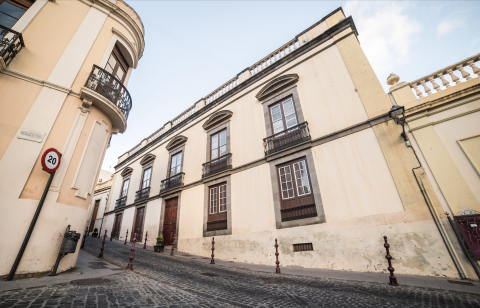
The Benítez de Lugo Viña House is a late 16th-century building with a neoclassical-romantic style facade that dates from a renovation in the early 19th century. The original house was built by the Benítez de Lugo family, marquises of La Florida, who were descendants of one of the first conquerors of Tenerife.
After the conquest in the 16th century, the Spanish Crown gave the outposts of La Orotava to the conquerors and conquest investors. This house was one of those built by this first wave of settlers. They came to inhabit La Orotava with the natives, who formed part of their domestic staff and labour force for land cultivation under slavery until the mid-16th century.
If you continue down to number 17 on this street, you’ll see another example of one of the town’s first houses, the Benítez de Lugo house, which was built in the 16th century. It’s recognisable from its closed balcony with 19th-century guillotine windows.
One of the most important figures in the history of the town lived here: Luis Francisco Benitez de Lugo, the eighth Marquis of Florida. Born in 1837, he was a writer and statesman who became a member of parliament during the First Spanish Republic. His home was a must-stop for all the figures that visited La Orotava. The Marquis of La Florida was a crucial figure in the opening up of the town to liberal ideas that would mark 19th-century Spain.
His academic and political career is well-known, but not everyone knows about his other curious hobby. He was widely considered to be one of the great pioneers of spiritualism in Spain. It was said that he could lift tables without touching them. His firm belief in the existence of spirits led him to promote a legislative proposal for the official teaching of spiritualism in Spain. This law, which never came to light, included a syllabus with subjects such as magnetism, lucid sleepwalking, spontaneous phenomena, and communication systems with the invisible world.
The next stop isn’t far away. Continue up this street until you find a magnolia tree on the path to the right. Take your camera on this part of the tour while you discover places like the Benítez de las Cuevas House, at number 26, which was built in the 17th century and is recognisable from the wooden cross on the side of its façade. Further up, on your left, the Callejón de Rodapalla is another of those charming places that attracts the attention of visitors. Listen to the next track when you arrive at the magnolia.





